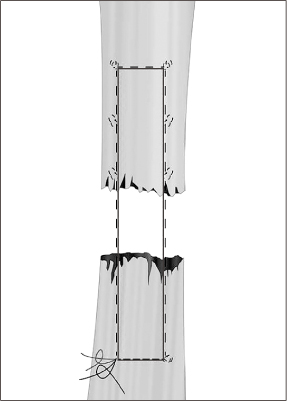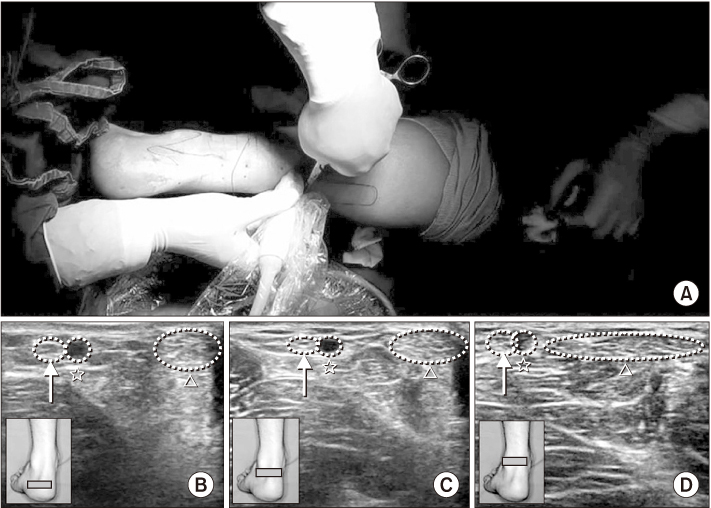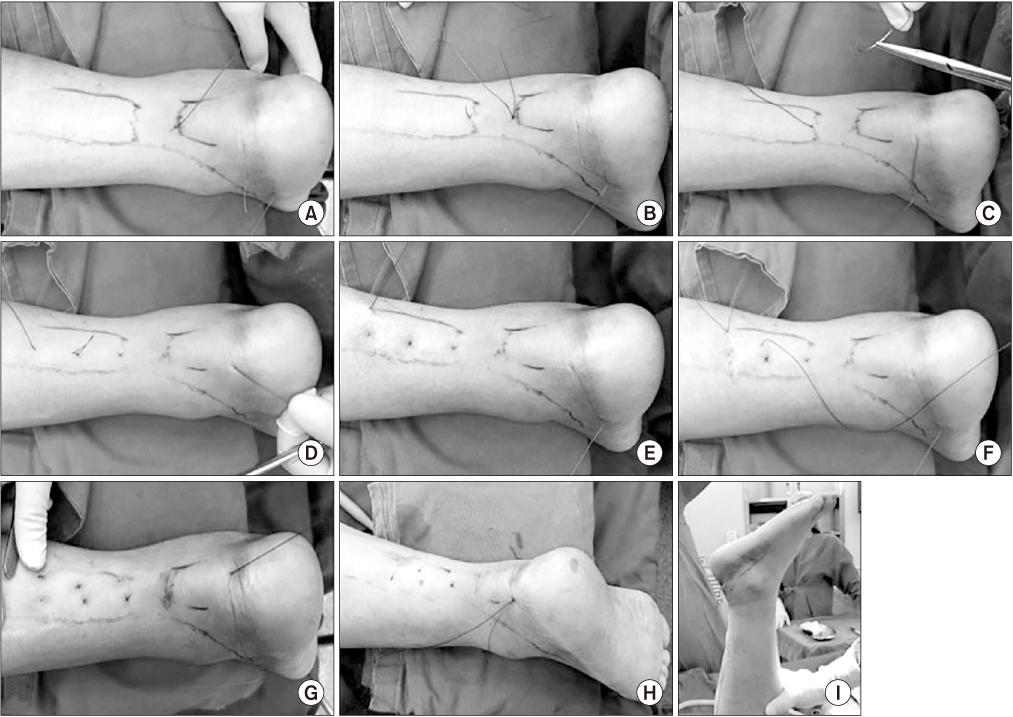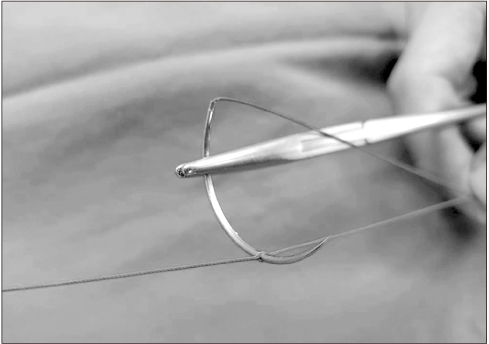J Korean Orthop Assoc.
2018 Dec;53(6):522-529. 10.4055/jkoa.2018.53.6.522.
Intraoperative Ultrasound-Guided Percutaneous Repair of a Ruptured Achilles Tendon: A Comparative Study with Open Repair
- Affiliations
-
- 1Department of Orthopedic Surgery, Chungnam National University School of Medicine, Daejeon, Korea. faschan@hanmail.net
- KMID: 2430059
- DOI: http://doi.org/10.4055/jkoa.2018.53.6.522
Abstract
- PURPOSE
To compare the clinical outcomes of ultrasound-guided percutaneous repair (USPR) and open repair in a ruptured Achilles tendon.
MATERIALS AND METHODS
The outcomes of 12 patients with USPR (group A) and 18 patients with open repair (group B) from January 2015 to February 2017 were analyzed retrospectively. The postoperative clinical evaluations were performed using the Arner-Lindholm scale, American Orthopedic Foot and Ankle Society (AOFAS) ankle-hindfoot score, Achilles tendon total rupture score (ATRS), and visual analogue scale for the overall satisfaction and cosmetic satisfaction with the scar, and the starting time of single heel raises. The complications were also evaluated.
RESULTS
The Arner-Lindholm scale, AOFAS ankle-hindfoot score, ATRS, starting time of single heel raises were similar in both groups (all p>0.05). Group A showed a significantly higher overall patient's satisfaction and cosmetic satisfaction in than group B (all p < 0.05). Two cases of Achilles tendon elongation were encountered in group A, and 1 case of re-rupture with deep infection and 1 case of superficial infection were experienced in group B.
CONCLUSION
USPR showed good clinical outcomes and high satisfaction as well as a low rate of complications, such as sural nerve injury. Therefore, USPR can be considered as an effective surgical treatment option for Achilles tendon ruptures.
MeSH Terms
Figure
Reference
-
1. Khan RJ, Fick D, Keogh A, Crawford J, Brammar T, Parker M. Treatment of acute achilles tendon ruptures. A meta-analysis of randomized, controlled trials. J Bone Joint Surg Am. 2005; 87:2202–2210.2. Yang B, Liu Y, Kan S, et al. Outcomes and complications of percutaneous versus open repair of acute Achilles tendon rupture: a meta-analysis. Int J Surg. 2017; 40:178–186.
Article3. Soroceanu A, Sidhwa F, Aarabi S, Kaufman A, Glazebrook M. Surgical versus nonsurgical treatment of acute Achilles tendon rupture: a meta-analysis of randomized trials. J Bone Joint Surg Am. 2012; 94:2136–2143.4. Jacobs D, Martens M, Van Audekercke R, Mulier JC, Mulier F. Comparison of conservative and operative treatment of Achilles tendon rupture. Am J Sports Med. 1978; 6:107–111.
Article5. Kim JH, Gwak HC, Lee CR, Kim JG, Jeong JW. A comparative study of surgical treatment result in the ruptured Achilles tendon: minimal incision percutaneous repair and open repair. J Korean Orthop Assoc. 2017; 52:249–256.
Article6. Sutherland A, Maffulli N. A modified technique of percutaneous repair of ruptured Achilles tendon. Orthop Trauma. 1999; 7:288–295.7. Assal M, Jung M, Stern R, Rippstein P, Delmi M, Hoffmeyer P. Limited open repair of Achilles tendon ruptures: a technique with a new instrument and findings of a prospective multicenter study. J Bone Joint Surg Am. 2002; 84:161–170.8. Wilkins R, Bisson LJ. Operative versus nonoperative management of acute Achilles tendon ruptures: a quantitative systematic review of randomized controlled trials. Am J Sports Med. 2012; 40:2154–2160.9. Kang C, Hwang DS, Hwang JM, Song JH, Shin BK, Park JH. Treatment of Achilles tendon rupture with absorbable suture. J Korean Foot Ankle Soc. 2014; 18:115–118.
Article10. Arner O, Lindholm A. Subcutaneous rupture of the Achilles tendon; a study of 92 cases. Acta Chir Scand Suppl. 1959; 116:1–51.11. Kitaoka HB, Alexander IJ, Adelaar RS, Nunley JA, Myerson MS, Sanders M. Clinical rating systems for the ankle-hindfoot, midfoot, hallux, and lesser toes. Foot Ankle Int. 1994; 15:349–353.
Article12. Nilsson-Helander K, Thomeé R, Silbernagel KG, et al. The Achilles tendon Total Rupture Score (ATRS): development and validation. Am J Sports Med. 2007; 35:421–426.13. Singer AJ, Thode HC Jr. Determination of the minimal clinically significant difference on a patient visual analog satisfaction scale. Acad Emerg Med. 1998; 5:1007–1011.
Article14. Gigante A, Moschini A, Verdenelli A, Del Torto M, Ulisse S, De Palma L. Open versus percutaneous repair in the treatment of acute Achilles tendon rupture: a randomized prospective study. Knee Surg Sports Traumatol Arthrosc. 2008; 16:204–209.
Article15. Ma GW, Griffith TG. Percutaneous repair of acute closed ruptured achilles tendon: a new technique. Clin Orthop Relat Res. 1977; (128):247–255.16. Karabinas PK, Benetos IS, Lampropoulou-Adamidou K, Romoudis P, Mavrogenis AF, Vlamis J. Percutaneous versus open repair of acute Achilles tendon ruptures. Eur J Orthop Surg Traumatol. 2014; 24:607–613.
Article17. Hsu AR, Jones CP, Cohen BE, Davis WH, Ellington JK, Anderson RB. Clinical outcomes and complications of percutaneous Achilles repair system versus open technique for acute Achilles tendon ruptures. Foot Ankle Int. 2015; 36:1279–1286.
Article18. Porter KJ, Robati S, Karia P, Portet M, Szarko M, Amin A. An anatomical and cadaveric study examining the risk of sural nerve injury in percutaneous Achilles tendon repair using the Achillon device. Foot Ankle Surg. 2014; 20:90–93.
Article19. Klein W, Lang DM, Saleh M. The use of the Ma-Griffith technique for percutaneous repair of fresh ruptured tendo Achillis. Chir Organi Mov. 1991; 76:223–228.20. Soubeyrand M, Serra-Tosio G, Campagna R, Molina V, Sitbon P, Biau DJ. Intraoperative ultrasonography during percutaneous Achilles tendon repair. Foot Ankle Int. 2010; 31:1069–1074.
Article21. Blankstein A, Israeli A, Dudkiewicz I, Chechik A, Ganel A. Percutaneous Achilles tendon repair combined with real-time sonography. Isr Med Assoc J. 2007; 9:83–85.22. Giannetti S, Patricola AA, Stancati A, Santucci A. Intraoperative ultrasound assistance for percutaneous repair of the acute Achilles tendon rupture. Orthopedics. 2014; 37:820–824.
Article23. Lacoste S, Féron JM, Cherrier B. Percutaneous Tenolig(®) repair under intra-operative ultrasonography guidance in acute Achilles tendon rupture. Orthop Traumatol Surg Res. 2014; 100:925–930.
Article24. McCoy BW, Haddad SL. The strength of achilles tendon repair: a comparison of three suture techniques in human cadaver tendons. Foot Ankle Int. 2010; 31:701–705.
Article25. Bourne RB, Bitar H, Andreae PR, Martin LM, Finlay JB, Marquis F. In-vivo comparison of four absorbable sutures: Vicryl, Dexon Plus, Maxon and PDS. Can J Surg. 1988; 31:43–45.26. Ashammakhi N, Gonzalez AM, Törmälä P, Jackson IT. New resorbable bone fixation. Biomaterials in craniomaxillofacial surgery: present and future. Eur J Plast Surg. 2004; 26:383–390.
Article27. Zhou Y, Guthrie G, Chuang A, Faro JP, Ali V. Unidirectional barbed suture versus interrupted vicryl suture in vaginal cuff healing during robotic-assisted laparoscopic hysterectomy. J Robot Surg. 2014; 8:201–205.
Article28. Kocaoglu B, Ulku TK, Gereli A, Karahan M, Turkmen M. Evaluation of absorbable and nonabsorbable sutures for repair of achilles tendon rupture with a suture-guiding device. Foot Ankle Int. 2015; 36:691–695.
Article29. Baig MN, Yousaf I, Galbraith JG, Din R. Absorbable Polydioxanone (PDS) suture provides fewer wound complications than polyester (ethibond) suture in acute Tendo-Achilles rupture repair. Ir Med J. 2017; 110:566.30. Clanton TO, Haytmanek CT, Williams BT, et al. A biomechanical comparison of an open repair and 3 minimally invasive percutaneous Achilles tendon repair techniques during a simulated, progressive rehabilitation protocol. Am J Sports Med. 2015; 43:1957–1964.
Article
- Full Text Links
- Actions
-
Cited
- CITED
-
- Close
- Share
- Similar articles
-
- Surgical Treatment of the Ruptured Achilles Tendon: A Comparative Study between Percutaneous and Open Repair
- A Comparative Study of Surgical Treatment in the Ruptured Achilles Tendon: Minimal incision and Open repair
- A Comparative Study of Surgical Treatment Result in the Ruptured Achilles Tendon: Minimal Incision Percutaneous Repair and Open Repair
- Heterotopic Ossification of a Partially Ruptured Achilles Tendon (A Case Report)
- Long Term Result of Four Cases without a Staged Reconstruction of an Infected Achilles Tendon Following Repair






